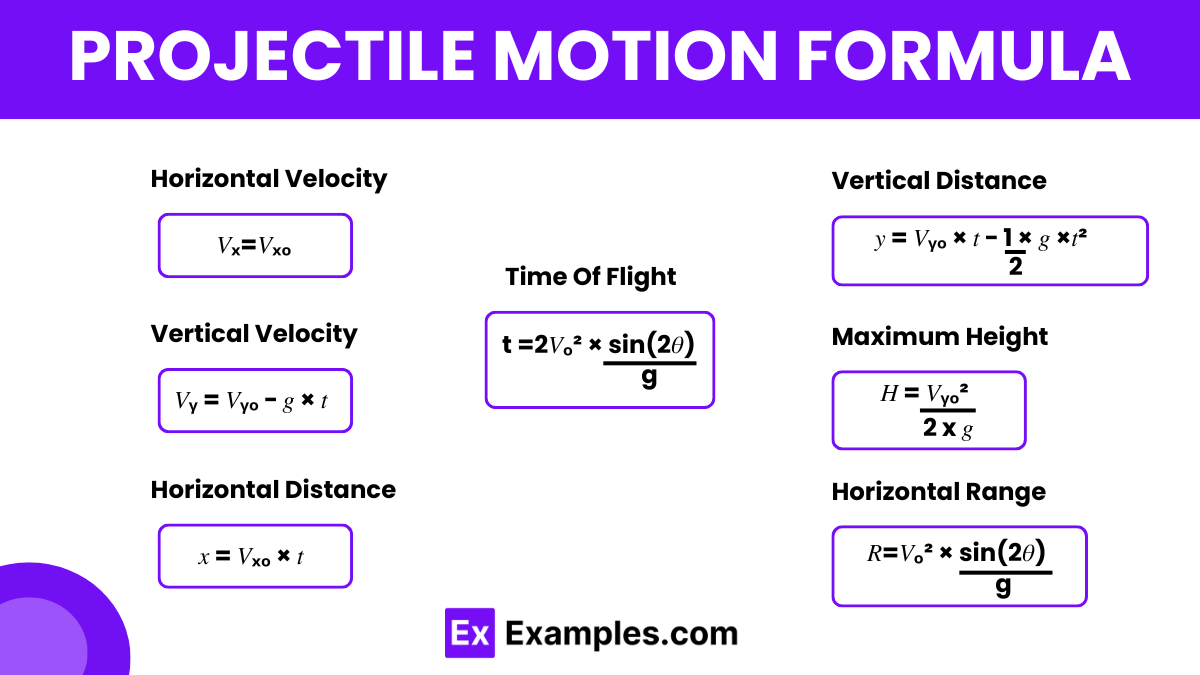Which of the following is the formula for the horizontal range of a projectile?
R = v₀².sin(2θ)/g
R = v₀ tcos(θ)
R=v₀².cos²(θ)/g
R = v₀ tsin(θ)


Projectile motion is a captivating topic in physics, deeply rooted in the foundational work of Galileo Galilei. Galileo was the first to accurately describe the characteristics of projectile motion, distinguishing the independent roles of horizontal and vertical motions in the trajectory of an object under the influence of gravity. The key formulas that calculate the velocity, distance, and trajectory of a projectile. The horizontal velocity (𝑉ₓ) of a projectile is constant throughout its flight, given by
In contrast the, c (𝑉ᵧ) changes over time due to gravity and is calculated using the formula
The projectile’s horizontal distance is simply
reflecting the consistency of horizontal motion. Meanwhile, the vertical distance (y) it covers is determined by
To calculate the maximum height (𝐻) a projectile reaches, we use
The total horizontal range (R) of the projectile is derived from
highlighting the influence of the launch angle (𝜃) and initial velocity (𝑉ₒ). The time of flight until the projectile hits the ground again (assuming it lands back at the same vertical level it was launched) can be found by setting 𝑦(𝑡)=0 and solving for 𝑡 :
Solving this quadratic equation, we get:
This is the total time the projectile spends in the air. These formulas are essential tools in physics, enabling accurate predictions and a deeper understanding of the motion of objects in a gravitational field.
Problem: A soccer player kicks a ball at an initial vertical velocity of 20 𝑚/𝑠. Calculate the maximum height the ball reaches.
Solution: We use the formula for maximum height: 𝐻=𝑉ᵧₒ² / 2𝑔
Plugging in the values: 𝐻 = (20 𝑚/𝑠)² / (2×9.81 𝑚/𝑠²) = 40019.62 ≈ 20.39 𝑚
Result: The soccer ball reaches a maximum height of approximately 20.39 𝑚.
Problem: An athlete throws a javelin at a speed of 30 𝑚/𝑠 from an angle of 45 relative to the Horizontal. Calculate the horizontal range of the javelin.
Solution: The formula for Horizontal range is: 𝑅 = ( 𝑉ₒ² × sin(2𝜃) ) / 𝑔
For 𝜃=45, sin(90) = 1:
𝑅 = (30 𝑚/𝑠)² × 19.81 𝑚/𝑠² = 9009.81 ≈ 91.74 𝑚
Result: The javelin covers a Horizontal distance of approximately 91.74 𝑚.
Problem: A basketball is thrown with an initial Velocity of 12 𝑚/𝑠 at an angle of 60. Calculate the total time the basketball spends in the air.
Solution: First, calculate the initial Vertical Velocity (𝑉ᵧₒ):
𝑉ᵧₒ = 𝑉ₒ × sin(𝜃) = 12 𝑚/𝑠 × sin(60) = 12 × 0.866≈10.392 𝑚/𝑠
The total time in the air (𝑡t) is given by the time to rise to the peak and the time to fall back down, using:
𝑡=(2 ×𝑉ᵧₒ ) / 𝑔 = ( 2 × 10.392 𝑚/𝑠 ) / 9.81 𝑚/𝑠² ≈ 2.12 𝑠
Result: The basketball stays in the air for approximately 2.12 𝑠𝑒𝑐𝑜𝑛𝑑𝑠.
The projectile motion formula calculates the path, range, and duration of an object thrown into the air under gravity’s influence.
A trajectory is the curved path a projectile follows.
Calculate a projectile’s flight time using: 𝑡=2𝑢 sin(𝜃) / 𝑔.
Text prompt
Add Tone
10 Examples of Public speaking
20 Examples of Gas lighting
Which of the following is the formula for the horizontal range of a projectile?
R = v₀².sin(2θ)/g
R = v₀ tcos(θ)
R=v₀².cos²(θ)/g
R = v₀ tsin(θ)
What is the time of flight for a projectile launched at an angleθ with initial velocity v₀?
t = v₀.sin(θ)/g
t = 2v₀.cos(θ)/g
t = 2v₀.sin(θ)/g
t = v₀.sin(2θ)/g
At what angle θ should a projectile be launched to achieve maximum range?
30∘
45∘
60∘
90∘
Which component of the initial velocity v₀ remains constant throughout the projectile's flight?
Horizontal component
Vertical component
Vertical component
Vertical component
For a projectile launched at an angle θ, what is the initial horizontal velocity component?
v₀.sin(θ)
v₀.cos(θ)
v₀.tan(θ)
v₀.sec(θ)
A projectile is launched at an angle of 30∘ with an initial velocity of 20 m/s. What is its initial vertical velocity component?
10 m/s
17.32 m/s
20 m/s
34.64 m/s
What is the acceleration in the horizontal direction for a projectile in flight?
g
−ᵍ
0
Depends on the initial velocity
Which of the following affects the time of flight of a projectile?
Initial speed only
Launch angle only
Both initial speed and launch angle
Neither initial speed nor launch angle
Which angle will result in the same range for a projectile as an angle of 30 ∘?
45∘
60∘
90∘
120∘
Which of the following factors does NOT affect the maximum height of a projectile?
Initial speed
Launch angle
Gravity
Horizontal component of velocity
Before you leave, take our quick quiz to enhance your learning!

